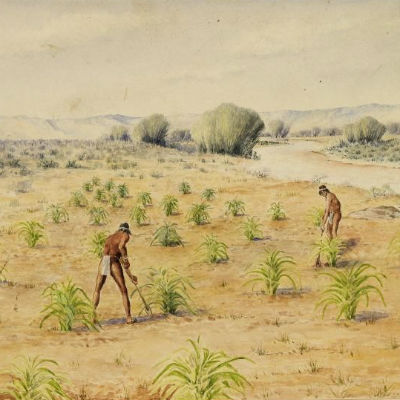Last updated: December 9, 2021
Lesson Plan
Plants, Pollen, and People: Archeology and Pollen Analysis

- Grade Level:
- Middle School: Sixth Grade through Eighth Grade
- Subject:
- Science
- Lesson Duration:
- 30 Minutes
- Common Core Standards:
- 6.RI.4, 6.RI.7, 9-10.RST.1, 9-10.RST.3, 9-10.RST.4, 9-10.RST.7
- Thinking Skills:
- Remembering: Recalling or recognizing information ideas, and principles. Applying: Apply an abstract idea in a concrete situation to solve a problem or relate it to a prior experience. Analyzing: Break down a concept or idea into parts and show the relationships among the parts. Creating: Bring together parts (elements, compounds) of knowledge to form a whole and build relationships for NEW situations.
Essential Question
How do archeologists use pollen analysis to study life within the past? What can pollen studies reveal about past environments and human actions?
Este plan de clase con actividades incluido también está disponible en español.
Objective
1. Learn how archeologists use pollen to learn more about past lifeways and environmental conditions.
2. Explore the methodological steps involved in pollen analysis.
3. Understand how archeologists interpret the results of pollen analysis.
This lesson plan and activities is available in Spanish.
Background
Archeology is an interdisciplinary field that utilizes a wide range of historical and scientific methodologies to study human life in the past. When analyzing a site, archeologists use techniques from multiple fields such as biology, geology, and chemistry.
Pollen analysis is one scientific method that archeologists use. Archeologists combine collected pollen data with historical research to answer questions about environmental conditions and human actions of the past, and the influences each had upon the other.
Preparation
Students will need pencils or pens and scrap paper.
Materials
Download Pollen Analysis Student Handout
Download Pollen Analysis Student Activity Sheet
Download Teacher Pollen Analysis Answer Key
Download En Español: Plantas, polen y personas: arqueología y el análisis del polen
Download En Español: Guía para el estudiante
Download En Español: Actividad: análisis del polen
Download En Español: Análisis del polen Hoja de respuestas
Procedure
Step 1: Download the resources included with this lesson plan. Provide each student with a printed copy.
Step 2: Have students read the provided background information about archeology and the steps of pollen analysis.
Step 3: Have the students complete the simulated pollen analysis activity. Review their answers.
Vocabulary
Absolute dating: a scientific method used to estimate how old archeological objects are utilizing exact historical dates
Archeology: the scientific study of humans within the past
Archeobotany: the study of plant remains on archeological sites
Auger: a hollow, metal tool used to gather soil samples
Palynology: the study of ancient pollen
Pollen core: a sample of stratigraphic soil layers and the pollen samples within them
Pollen rain: the natural process of plant and tree pollen falling from the plant and being mixed into the soil
Radiocarbon/carbon-14 analysis: scientific method used to date organic archeological objects, such as wood and bone, utilizing the known decay rate of carbon-14
Relative dating: a scientific method to approximate the age of archeological objects in relation to each other
Stratigraphy: the scientific study of rock and soil layers
Supports for Struggling Learners
Teachers can ask students to read the text out loud. After each section, teachers can review the main points with the students.
Enrichment Activities
Research ways that ancient people within your local area used plants and trees. What kind of evidence might archeologists look for that could tell them about those practices?
Additional Resources
“A History of Illinois Agriculture: Illinois Agriculture Begins.” Illinois State Museum.
